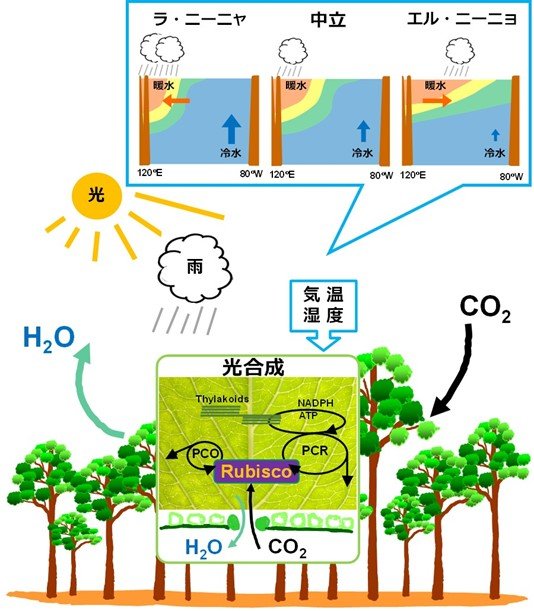Prof. Kume and his research group revealed that El Niño determined the absorption of carbon dioxide by tropical rainforests.
*The following sentences are translated by the automatic translation function.
POINT
- The carbon dioxide and water vapor exchanged between the rainforest and the atmosphere have significant implications for the global carbon budget and water cycle. Interannual variations in carbon sequestration in the Borneo rainforest have been thought to be influenced by the El Niño Southern Oscillation (ENSO), but the mechanism, or even whether this is really the case, is not known.
- Simulation models based on 10 years of field observations and observational data, including several ENSO events (El Niño and La Niña), have shown that the rate of forest unit carbon dioxide absorption is greater during La Niña and smaller during El Niño, and that this is due to the photosynthetic capacity ( The maximum carbonate fixation rate of the Calvin-Benson circuit) is larger during La Niña and smaller during El Niño.
- The findings will help us understand how Southeast Asian rainforests have accumulated carbon over the long term and predict future carbon budgets not only for Southeast Asian rainforests, but also for the global carbon budget.
SUMMARY
Professor Tomo'omi Kumagai, Project Researcher Yoshiaki Hata, and Graduate Student Naoya Takamura of the Graduate School of Agricultural and Life Sciences, the University of Tokyo, in collaboration with Associate Professor Kazuho Matsumoto of the University of the Ryukyus, Professor Tomonori Kume of Kyushu University, and Associate Professor Masahito Ueyama of Osaka Public University, have conducted a study in the tropical rain forest of Borneo, including several El Niños and La Niñas (Note 1, Figure 1) They found that the rate of carbon dioxide absorption by forest units increases during La Niña and decreases during El Niño, and that the photosynthetic capacity (the maximum carbonate fixation reaction rate of the Calvin-Benson circuit (Note 2, Fig. 1)) increases during La Niña and decreases during El Niño. The photosynthetic capacity (the maximum carbonate fixation reaction rate of the Calvin-Benson circuit (Note 2, Fig. 1)) is larger during La Niña and smaller during El Niño.

Research-related inquiries
Tomonori Kume,Professor












 Contact
Contact
 Access Map
Access Map

